Finite Volume Element Approximation for the Elliptic Equation with Distributed Control
Abstract
In this paper, we consider a priori error estimates for the finite volume element schemes of optimal control problems, which are governed by linear elliptic partial differential equation. The variational discretization approach is used to deal with the control. The error estimation shows that the combination of variational discretization and finite volume element formulation allows optimal convergence. Numerical results are provided to support our theoretical analysis.
1. Introduction
In recent years, the optimization with partial differential equation constraints (PDEs) has received a significant impulse. Because of wide applicability of the field, a lot of theoretical results have been developed. Generally, it is difficult to obtain the analytical solutions for optimal control problems with PDEs. Factually, only approximate solutions or numerical solutions can be expected. Therefore, many numerical methods have been proposed to solve the problems.
Finite element method is an important numerical method for the problems of partial differential equations and widely used in the numerical solution of optimal control problems. There are extensive studies in convergence of finite element approximation for optimal control problems. For example, priori error estimates for finite element discretization of optimal control problems governed by elliptic equations are discussed in many publications. In [1], a new approach to error control and mesh adaptivity is described for the discretization of the optimal control problems governed by elliptic partial differential equations. In [2], the error estimates for semilinear elliptic optimal controls in the maximum norm are presented. Chen and Liu present a priori error analysis for mixed finite element approximation of quadratic optimal control problems [3]. In [4], a priori error analysis for the finite element discretization of the optimal control problems governed by elliptic state equations is considered. Hou and Li investigate the error estimates of mixed finite element methods for optimal control problems governed by general elliptic equations and derive L2 and H1 error estimates for both the control and state variables [5].
The finite volume element method has been one of the most commonly used numerical methods for solving partial differential equations. The advantages of the method are that the computational cost is less than finite element method, and the mass conservation law is maintained. So it has been extensively used in computational fluid dynamics [6–12]. However, there are only a few published results on the finite volume element method for the optimal control problems. In [13], the authors discussed distributed optimal control problems governed by elliptic equations by using the finite volume element methods. The variational discretization approach is used to deal with the control and the error estimates are obtained in some norms. In [14], the authors considered the convergence analysis of discontinuous finite volume methods applied to distributed optimal control problems governed by a class of second-order linear elliptic equations.
In this paper, we will investigate the finite volume element method for the general elliptic optimal control problem with Dirichlet or Neumann boundary conditions. The variational discretization approach is used to deal with the control, which can avoid explicit discretization of the control and improve the approximation. In addition, we discuss the optimal control problems in polygonal domains with corner singularities. In this situation, the solution does not admit integrable second derivatives. The desired convergence results of finite volume element schemes cannot be expected. Two effective methods are proposed to compensate the negative effects of the corner singularities. The corresponding results will be reported in the future.
The rest of the paper is organized as follows. In Section 2, the model problem and the finite volume element schemes are introduced. Section 3 presents the error estimates of the finite volume element schemes. In Section 4, numerical results are supplied to justify the theoretical analysis. Brief conclusions are given in Section 5.
2. Problem Statement and Discretization
2.1. Model Problem
From standard arguments for elliptic equations, we can obtain the following propositions.
Proposition 1. For fixed control u ∈ L2(Ω), the state equation (3) admits a unique solution y ∈ H. Moreover, there is a constant C, which does not depend on Bu + f, such that
Proposition 2. Let Uad be a nonempty, closed, bounded, and convex set, yΩ in L2(Ω) and λ > 0; then the optimal control problem (6) admits a unique solution .
This proof follows standard techniques [15].
Proposition 3. The necessary and sufficient optimality conditions for (6) and (7) can be expressed as the variational inequality
2.2. Discretization
Now we describe the finite volume element discretization of the optimal control problem (6).
We consider a quasi-uniform triangulation Th. Divide into a sum of finite number of small triangles K such that they have no overlapping internal region and a vertex of any triangle does not belong to a side of any other triangle. At last, we can obtain a triangulation such that .
We then construct a dual mesh related to Th. Let P0 be a node of a triangle, Pi (i = 1,2, …, 6) the adjacent nodes of P0, and Mi the midpoint of . Choose the barycenter Qi of triangle ∆P0PiPi+1 (P7 = P1) as the node of the dual mesh. Connect successively M1, Q1,…, M6, Q6, M1 to form a polygonal region V, called a control volume. Figure 1 presents a sketch of a control volume.
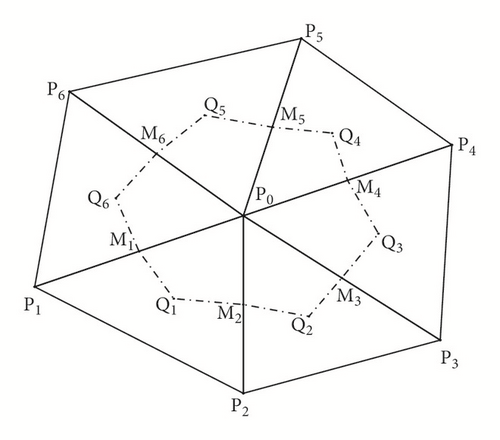
3. Error Estimates
In order to present the error estimates, we first introduce some lemmas in preparation of the proof for the main convergence theorem.
3.1. Some Lemmas
According to [16], we have the following lemma, which indicates that the bilinear form is coercive on Uh.
Lemma 4. is positive definite for small enough h; namely, there exist h0 > 0, α > 0 such that for 0 < h ≤ h0
We seldom have a symmetric bilinear form even though a(·, ·) is symmetric. The following lemma is used to measure how far the bilinear form is from being symmetric [17].
Lemma 5. There exist positive constants C, h0 such that, for u, w ∈ Uh and 0 < h ≤ h0, we have
Lemma 6. Let and be the solution of (18) and (19) and , be the solution of (24). Then, we have
Proof. Combining (18) and (24), we have
The results in [18] can easily be extended to cover the elliptic equations with homogeneous Neumann boundary conditions. Now we list the useful theoretical results in the following lemma.
3.2. L2 Error Estimate
Theorem 8. Assume that and are the solutions of (6) and (20), respectively, , f, yΩ ∈ H1(Ω), and A ∈ W2,∞. Then there exists a positive constant C > 0 and h0 > 0 such that for 0 < h ≤ h0
Proof. Let us test (12) with , and (20) with , and sum up the two inequalities; we have
Theorem 9. Assume that are the solutions of (6) and (11), respectively, and are the solutions of (18) and (19), respectively, , f, yΩ ∈ H1(Ω), and A ∈ W2,∞. Then there exists a positive constant C > 0 such that
3.3. H1 Error Estimate
Theorem 10. Assume that are the solutions of (6) and (11), respectively, and are the solutions of (18) and (19), respectively, , f, yΩ ∈ L2(Ω), and A ∈ W1,∞. Then there exists a positive constant C > 0 such that
Proof. Using the triangle inequality, we have
3.4. L∞ Error Estimate
Theorem 12. Assume that are the solutions of (18), (19), and (20), respectively, , f, yΩ ∈ H1(Ω), and A ∈ W2,∞. Then there exists a positive constant C > 0 such that
4. Numerical Experiments
4.1. Experiment 1
Errors of finite volume element schemes in L∞, L2, and H1 norm are computed. Data are listed in Tables 1–3. In Tables 1 and 3, errors in H1 norm have optimal convergence order for both control and adjoint state. These results confirm our theoretical error analysis (44). In Table 2, due to additional smoothness of the state, the H1 error is O(h2). The convergence results in Tables 1–3 demonstrate second-order accuracy in L∞ and L2 norm for the control, state, and adjoint state.
| h | L∞ error | r | L2 error | r | H1 error | r |
|---|---|---|---|---|---|---|
| 1/8 | 1.7412E-01 | - | 4.4468E-02 | - | 2.3006 | - |
| 1/16 | 4.1870E-02 | 2.05 | 1.0374E-02 | 2.09 | 1.1313 | 1.02 |
| 1/32 | 1.0476E-02 | 2.00 | 2.5558E-03 | 2.02 | 5.6371E-01 | 1.00 |
| 1/64 | 2.6171E-03 | 2.00 | 6.3685E-04 | 2.00 | 2.8162E-01 | 1.00 |
| h | L∞ error | r | L2 error | r | H1 error | r |
|---|---|---|---|---|---|---|
| 1/8 | 1.1429E-03 | - | 3.7634E-04 | - | 5.3988E-03 | - |
| 1/16 | 2.1927E-04 | 2.38 | 8.5181E-05 | 2.14 | 1.1332E-03 | 2.25 |
| 1/32 | 5.1326E-05 | 2.09 | 2.0833E-05 | 2.03 | 2.7140E-04 | 2.06 |
| 1/64 | 1.2609E-05 | 2.03 | 5.1751E-06 | 2.01 | 6.7061E-05 | 2.02 |
| h | L∞ error | r | L2 error | r | H1 error | r |
|---|---|---|---|---|---|---|
| 1/8 | 1.7415E-02 | - | 4.4468E-02 | - | 2.3006 | - |
| 1/16 | 4.1867E-02 | 2.06 | 1.0373E-02 | 2.09 | 1.1313 | 1.02 |
| 1/32 | 1.0473E-02 | 1.99 | 2.5552E-03 | 2.02 | 5.6371E-01 | 1.00 |
| 1/64 | 2.6159E-03 | 2.00 | 6.3655E-04 | 2.01 | 2.8162E-01 | 1.00 |
Figure 2 depicts the development of the L∞, L2, and H1 error for the control, state, and adjoint state under uniform refinement of the mesh. From the figure, the expected order O(h2) in L∞ and L2 norm for the control is observed, and the order O(h) in H1 norm is shown. Additionally, we observe convergence of order O(h2) in L∞ and L2 norm for state and adjoint state. Because of better smoothness of state, the order O(h2) in H1 norm is also observed.
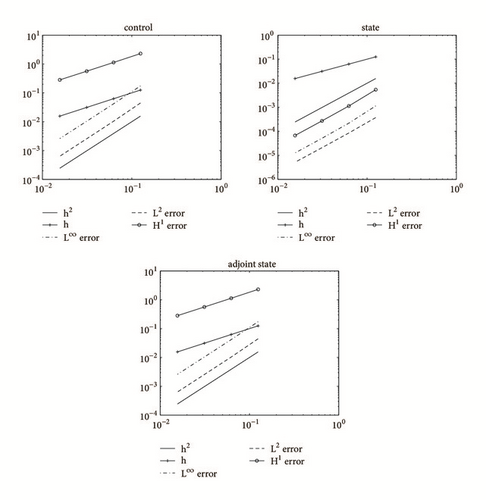
We perform a simulation with space size h = 1/32 for this problem. Figure 3 presents the computed state, optimal control, and adjoint state. Examination of Figure 3 shows that the approximate solutions coincide with the true solutions. At the same time, the relationship between the control and adjoint state is preserved well.
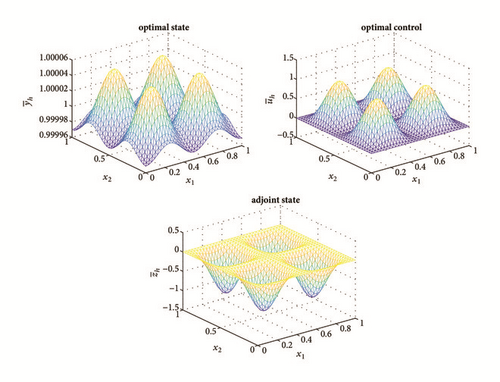
4.2. Experiment 2
The exact solution of the problem is not known in advance. So we use the numerical results computed on a grid with h = 1/256 as reference solutions. The L∞, L2, and H1 errors for state, control, and adjoint state of the above problems have been computed. They are displayed in Tables 4–6 for the finite volume element schemes. Examination of the tables shows that the error measures of the schemes diminish approximately quadratically for the error in L∞ and L2 norm and linearly for the error in H1 norm, which are consistent with our theoretical analysis.
| h | L∞ error | r | L2 error | r | H1 error | r |
|---|---|---|---|---|---|---|
| 1/8 | 4.2814E-03 | - | 2.7687E-03 | - | 2.2775E-02 | - |
| 1/16 | 1.2186E-03 | 1.81 | 7.7173E-04 | 1.84 | 1.2642E-02 | 0.85 |
| 1/32 | 2.9931E-04 | 2.02 | 1.8098E-04 | 2.09 | 5.4512E-03 | 1.21 |
| 1/64 | 7.6218E-05 | 1.97 | 4.0938E-05 | 2.14 | 2.2949E-03 | 1.24 |
| h | L∞ error | r | L2 error | r | H1 error | r |
|---|---|---|---|---|---|---|
| 1/8 | 5.2997E-04 | - | 3.8069E-04 | - | 2.9536E-03 | - |
| 1/16 | 1.3047E-04 | 2.02 | 1.0869E-04 | 1.81 | 1.7383E-03 | 0.76 |
| 1/32 | 3.2119E-05 | 2.02 | 2.7098E-05 | 2.00 | 7.6992E-04 | 1.17 |
| 1/64 | 7.9037E-06 | 2.02 | 6.2918E-06 | 2.10 | 3.3199E-04 | 1.21 |
| h | L∞ error | r | L2 error | r | H1 error | r |
|---|---|---|---|---|---|---|
| 1/8 | 5.9019E-04 | - | 3.9236E-04 | - | 3.0287E-03 | - |
| 1/16 | 1.6144E-04 | 1.87 | 1.1101E-04 | 1.82 | 1.7719E-03 | 0.77 |
| 1/32 | 4.2371E-05 | 1.93 | 2.8422E-05 | 1.97 | 8.0665E-04 | 1.13 |
| 1/64 | 1.0588E-05 | 2.00 | 6.9125E-06 | 2.04 | 3.6516E-04 | 1.14 |
In Figure 4, the development of the L∞, L2, and H1 error for control, state, and adjoint state under uniform refinement of the mesh is shown. Here, the expected order O(h2) in L∞ and L2 norm for the control is observed. Again, we observe convergence of order O(h2) in L∞ and L2 norm for state and adjoint state, which is consistent with our expectation of the order of convergence. The errors in H1 norm confirm our error estimation (11). Figure 5 displays the numerical solution computed by the finite volume element schemes with h = 1/16. The results are nearly the same as those in [19]. The relationship between the control and adjoint state is also preserved well.
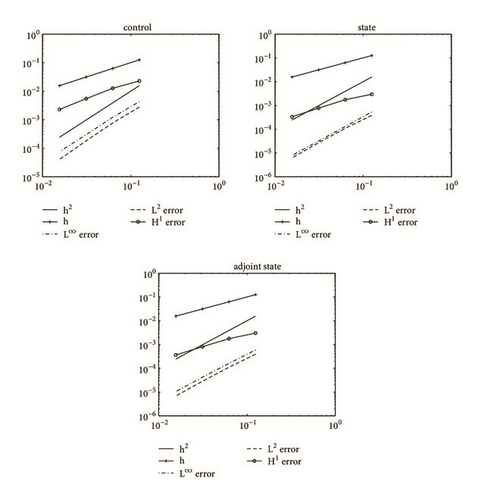
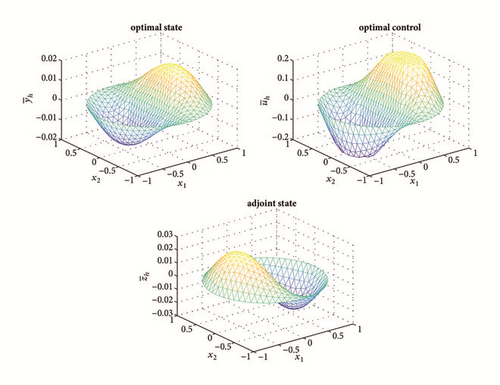
4.3. Experiment 3
Now we consider the optimal control problem (59) with Ω = (−1,1) 2∖([−1,0]×[0,1]) denoting an L-shaped domain, Uad = {u ∈ L2(Ω):−0.2 ≤ u ≤ 0.2}. Further, we set and λ = 0.1.
In this situation, the solution does not admit integrable second derivatives. The desired convergence results of finite volume element schemes cannot be expected. So we only present the numerical solutions of the finite volume element schemes in Figure 6, which are nearly the same as those in [19]. On one hand, the desired convergence results may be obtained by using graded meshes and postprocessing [20], which will need more computational cost. On the other hand, we can modify finite volume element schemes near the corner to obtain the second-order accuracy. The related results will be reported in the future.
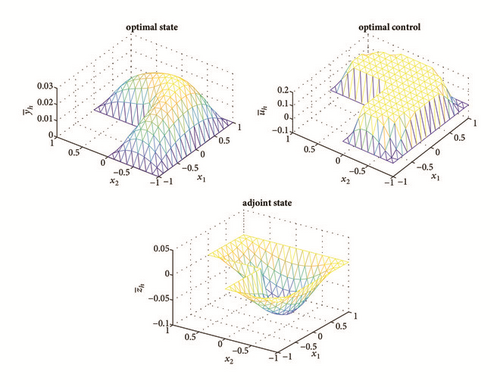
5. Conclusions
In this article, we have investigated the finite volume element discretizations of optimal control problems governed by linear elliptic partial differential equations and subject to pointwise control constraints. Optimal order L2, H1, and L∞ error estimates for the considered problems are obtained and numerical experiments validate the theoretical results. In addition, we discuss the optimal control problems in polygonal domains with corner singularities. Two effective methods are proposed to compensate the negative effects of the corner singularities. The corresponding results will be reported in the future.
Conflicts of Interest
The authors declare that they have no conflicts of interest.
Acknowledgments
This project is partially supported by the Fundamental Research Funds for the Central Universities (Nos. KYZ201565 and KJQN201839) and the National Natural Science Foundation of China (Nos. 11701283, 11426134, and 11471166).
Open Research
Data Availability
The data used to support the findings of this study are available from the corresponding author upon request.




